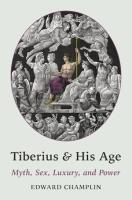
Princeton University Press (2024) h/b 269pp £32 (ISBN 9780691139241)
Princeton professor Edward Champlin is best known as an editor of the Cambridge Ancient History volume on the Age of Augustus (1996) and for his 2003 book Nero. Declining health prevented him from completing a planned study of Tiberius, but nine connected pieces (seven previously published in journals) are here edited by his colleague Robert Kaster to throw new light on the second Roman emperor.
Revisionist historians seek the clay feet of good emperors and whitewash mad or bad ones, but Tiberius is a mixture. Hostile portraits by Tacitus and Suetonius sit alongside favourable accounts in Velleius Paterculus and Philo of Alexandria. Apparent change over time is, for Tacitus, the revelation of inherent villainy, but C.’s emphasises complexity and unexpectedness throughout.
Tiberius got a raw deal. Augustus adopted his stepson as successor only after his nephew Marcellus and grandsons Gaius and Lucius Caesar had died, simultaneously forcing him to swap a happy marriage for an unhappy one with Augustus’ daughter Julia. When Augustus died, Tiberius seems to have been genuinely reluctant to take up a role still not clearly defined. He never got on well with the Senate, this enmity generating the vituperative tradition used by later historians.
C. in his earlier book showed Nero using mythology to create his own image and deploying the ‘politics of theatricality’. Similar themes are pursued here. C. looks first at recurrent and transferable stories. Accounts of a ruler presented with a large fish (from Polycrates in Herodotus onwards) develop in various ways, but always deal with power and its proper or improper use. The emperor’s curiosity about the events in Plutarch’s haunting story of the death of Pan, his use of a fable about sated flies to justify procrastination with ambassadors, and his own appearance in another where a slave is reproved for hoping to win freedom merely by dampening the dust in his path, all point to a conception of Tiberius as a wise monarch.
Castor and Pollux had been revered in Rome since their miraculous appearance at the battle of Lake Regillus in 496 BC. Even before his adoption by Augustus, Tiberius rebuilt the temple of Castor in the Forum to commemorate his younger brother Drusus after his death in 9 BC, implicitly casting himself as Pollux. Assimilation to deity echoed Augustus with Apollo, but by provocatively describing Drusus as ‘Claudianus’ (in an increasingly Julian-dominated setting) Tiberius arguably beat the emperor at his own game. The sculptures in the dining grotto of Tiberius’ villa at Sperlonga express an aspiration to identify with Odysseus, here to gratify himself and favoured guests rather than for public display.
Tiberius responds creditably to disasters that punctuate Tacitus’ narrative (a collapsing amphitheatre, a fire on the Caelian Hill) but the historian’s ‘startling excursus’ on the demise of the Phoenix bird in AD 34 sends C. on an equally startling exploration of ‘an alternative Tiberian thought-world’ involving recurrent fire omens, harmless combustion (recalling flames that played round the head of Servius Tullius in Livy) and heavy reliance on the astronomer Thrasyllus. Not all readers will be persuaded that the emperor was a paid-up Zoroastrian, but the Stoic idea of periodic cosmic conflagration was taken seriously and many people in the first century believed that the end of all things was at hand.
Subsequent chapters are briefer. Accounts of the debauchery of Tiberius’ last years on Capri are dismissed as standard invective against tyrants. Tacitean neologisms sellarii and spintriae are taken to refer not (as usually supposed) to male prostitutes but to participants in ‘risqué costume parties’ and ‘mythological tableaux vivants’. The otherwise unknown noblewoman Mallonia allegedly subjected to enforced oral sex is taken as a fictitious figure modelled on the Republican heroines Lucretia and Verginia in whose stories death was preferable to disgrace.
The final chapters deal with individuals ‘in the emperor’s orbit’. The declaimer and gourmand Asellius Sabinus was an ancient Noel Coward, noted for his urbanitas but unable to resist a jest in dire circumstances. This was for the Roman elite a golden age of gastronomy and power dining. Silly prices were paid for large mullets. Poems on food preparation proliferated, aggrandised by one Archestratus into Homeric parody. Both Apicius and the late antique cookbook attributed to him are conflations, but behind them stands an identifiable individual, reputedly the lover of the emperor’s most famous associate. Sejanus (like Caprean entertainment) is presented by C. as tamer than the sinister Tacitean version: as an influential equestrian he resembled Maecenas, and he seems to have modelled himself on Agrippa. Before falling spectacularly from favour, he had perhaps been seen as a serious candidate for succession.
By reassessing familiar sources and exploring many unfamiliar ones, C. has produced an imaginative and mostly convincing new portrait of an enigmatic figure. Copy editing and proofreading have been done to a high standard.
John Taylor
